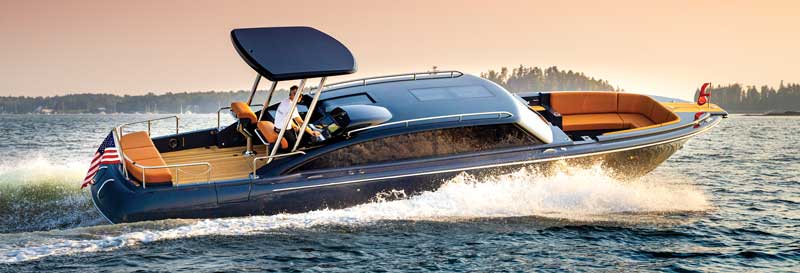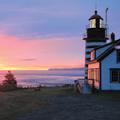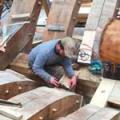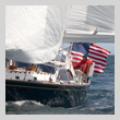Pumpkins, boats leaving town & a new editor
 The Sequoia being barged out of Belfast Harbor. Photo by Murray Carpenter
The Sequoia being barged out of Belfast Harbor. Photo by Murray Carpenter
Presidential yacht moves south
After spending four years on the hard in Belfast, Maine, awaiting restoration, the former presidential yacht Sequoia left the state in October on a barge. It took five days to tow her to the Richardson Maritime Museum in Cambridge, Maryland, where she will be restored. The vessel, which was in a deteriorated state, had been scheduled for a rebuild at the French & Webb yard in Belfast. At the time, Michael Cantor, Managing Partner of Equator Capital Group, which owns the vessel, hoped to restore the Sequoia on site. When those plans fell through in Belfast, he looked at other locations in Maine but found that moving the vessel, especially on land, was going to be difficult. So Cantor decided, instead, to bring the vessel back to Maryland.
The Sequoia has an interesting history in Cambridge, according to Cantor. President Franklin Roosevelt brought the yacht to Cambridge in 1935 to dedicate the Choptank River Bridge, an early New Deal-funded project; and Sequoia was the first vessel to pass under the new bridge.
Plans call for building a structure in Cambridge where the boat can be restored under cover.
“[Her] permanent home will be on the water,” Cantor said, “but Cambridge could be its home for repairs and refitting.” Designed by John Trumpy and built by the John H. Mathis & Co. Shipyard in Camden, New Jersey, Sequoia was launched in October 1925. Her first owners were Emily Roebling Cadwallader and her husband. The yacht was sold to the U.S. Bureau of Navigation in 1931, which used it as a decoy in the Chesapeake and Delaware bays to attract bootleggers. President Herbert Hoover brought the yacht into presidential service later that year.
Sequoia served every U.S. president from Hoover through Gerald Ford. President John Kennedy celebrated his 46th and final birthday aboard. President Roosevelt hosted the British Prime Minister on Sequoia to discuss the Depression and ways to avoid war with Hitler. President Nixon played “God Bless America” on a piano aboard the yacht after deciding to resign over Watergate.
President Jimmy Carter ordered the vessel, which has been designated as a National Historic Landmark, sold at auction in 1977. The yacht was sold several more times until Equator Capital won a lawsuit to gain possession.
“Once Sequoia is back in service, our intention is to base her in Washington, DC. She will cruise locally and along the East Coast, as a floating venue to teach American presidential history and to promote conservation and ocean conservation causes,” Cantor said.
So long to the Victory Chimes
Around the same time the Sequoia was barged south, the iconic 123-year-old schooner Victory Chimes was towed out of Rockland Harbor, headed to Pier 25 in Manhattan on the Hudson River, where she is expected to be converted into a floating restaurant.
In May, the three-masted, gaff-rigged schooner was sold at auction to brothers Miles and Alex Pincus, who operate seasonal bars and restaurants on two other old wooden sailing vessels.
The Victory Chimes is the last surviving Chesapeake ram schooner. She is a U.S. National Historic Landmark and is represented on the Maine State quarter.
Whale ho
An adolescent fin whale that beached itself and died in Steuben on Thanksgiving, floated away in a storm a few days later—prompting alerts for mariners to be on the lookout for a floating whale carcass. Authorities hoped to find the animal, which was nearly 50 feet long, to dissect it and determine why it died, said Rosemary Seton of Allied Whale, College of the Atlantic’s marine research division. Fin whales, which are second only to blue whales as the earth’s largest living creatures, are endangered.
Seton told the Bangor Daily News that Allied Whale hopes to relocate the whale and bring it ashore again, ideally at high tide. The whale was emaciated and likely wasn’t eating. If they can find it again before it decomposes too much, they might be able to examine its trachea to see if it may have had difficulty swallowing, Seton said. Anyone who comes across the dead whale, or any stranded or dead marine mammal, was asked to contact Allied Whale at 207-266-1326.
 Jonesport Shipyard has a new owner. Photo courtesy Jon Johansen
Jonesport Shipyard has a new owner. Photo courtesy Jon Johansen
Boatyard sales
A boatyard downeast was sold this fall, as was a yard in Manset. And it turns out the sales have a connection. Maine Coastal News Publisher Jon Johansen and his wife Ann bought the Jonesport Shipyard in Jonesport; the partners also acquired boat-related tools and materials from Wilbur Yachts after John and Ingrid Kachmar sold the Wilbur Yachts facility in Manset to a buyer who was not interested in continuing to run a marine business there.
John Kachmar said the sale of Wilbur Yachts’ land and buildings closed in late October. The Wilbur name did not convey in the sale, he added, noting that he is still operating the company’s brokerage business.
In Jonesport, Johansen said he plans to expand the yard there, adding more commercial work and upgrading some of the buildings.
“We will increase the number of boats we take care of and then we will see where we go from there,” he said. “There is a lot of room for expansion.”
In addition to his work with the boating newspaper, Johansen is president of Maine Lobster Boat Racing, and does all the scoring for the races along the coast during the summer.
When contacted in late November, he was in the process of unloading three trailer loads of equipment from Wilbur, including the works for a machine shop.
Local fisherman Alonzo Alley will run the yard, Johansen said. In addition, long-time builder Joe Lowell, who has been working on wooden boats down in Yarmouth, plans to move his operation up to the shipyard, operating out of former builder Bert Frost’s old shop, which will be rebuilt, according to Johansen.
He said he also acquired all the Wilbur Yachts plans and archives, which have been donated to the Penobscot Marine Museum in Searsport.
Sune and Patricia Noreen bought the old Frost’s Shipyard Co. in 1985, renamed it the Jonesport Shipyard, and quickly became a mainstay of the downeast commercial and recreational boating community. But the yard had been on the market for a few years.
“These places are going to get bought up and disappear. It’s happening up and down the coast,” Johansen said, explaining his motivation for getting into the boatyard business.
On Mt. Desert Island, Lee S. Wilbur & Co./Wilbur Yachts was started in 1973 in a one-bay boatshop formerly located on Jim Willis’s property in Seawall. The building was moved onto Wilbur’s property in 1971. The Kachmars purchased Wilbur Yachts in Manset from Ingrid Kachmar’s parents, Lee Wilbur and Heidi Crock, in 2001. After the sale, Wilbur and Crock stayed on for two years, while the Kachmars learned the ropes in production and office operations.
“The time was right,” Kachmar said about the sale. “There are a lot of things I still want to do and the yard takes a lot of time, as you can imagine.”
Finding a use for fish waste
Seafood processors increasingly are finding value in fish guts, shells, and other “waste” products, according to a recent report. The report, commissioned by the Seafood Economic Accelerator for Maine, or SEA Maine, examines how Maine companies are utilizing their so-called residuals as ways to reduce waste and generate more revenue. According to the report, Maine’s fishing industry produces an estimated 57 million pounds of waste product annually. That’s about 25 percent of the total volume of seafood generated within Maine, according to a story in Mainebiz.
“We’ve been investing in our residuals for several years now,” Luke Holden, founder and president of Luke’s Lobster in Portland, told Mainebiz. “We started with a simple plant food product, but we continue to look for additional opportunities for higher value use of the residuals we produce.”
Some residuals, such as chitin from lobster shells, already have a known value. Lobster shells are a main ingredient in a new commercial product for treating psoriasis. Additional projects are investigating its potential use for plastics and medical products.
Lobster byproducts also are used as a natural plant food. Luke’s Lobster has launched a lobster-shell plant fertilizer that provides an organic source of nitrogen, calcium, potassium, and phosphorus for gardeners, according to Mainebiz.
 Photo courtesy Charles Lagerbom
Photo courtesy Charles Lagerbom
Underwater pumpkin carving
Yes, you read that right. While some of us were crouched in the backyard carefully carving scary faces on our pumpkins last Halloween, a group of intrepid divers in Rockland Harbor was testing their carving skills underwater.
Five members of the local SCUBA dive club Mid-Coast Maine Aqua-Nuts participated in the first Annual Aqua-Nut Underwater Pumpkin Carving event, according to Charles Lagerbom. The divers hollowed out their pumpkins before taking them into the water. Once down under, the carving took some getting used to, Lagerbom said. “I found you had to hold the pumpkin somewhat with your knees while sawing away,” he explained, “Plus pumpkins tend to be positive buoyant, which required me placing some extra lead weights inside to keep them from floating away.”
A small crowd of onlookers cheered the divers and their works of art as they emerged from the harbor. The divers already are planning next year’s event.
Round the world racer
Cole Brauer, who lived in and sailed out of Boothbay Harbor for several years, is attempting to make history in the Global Solo Challenge. At just 29 years old, Brauer, who now calls Newport, Rhode Island home, is one of five Americans out of 20 skippers competing in the race. She is both the youngest skipper and the only female sailor in the fleet. If successful, she will be the first American woman to have raced solo around the globe.
The Solo Global Challenge is a nonstop solo race by 20 skippers around the three capes: Africa’s Cape of Good Hope; Australia’s Cape Leeuwin; and South America’s Cape Horn. The race has a pursuit start, meaning that competitors were assigned a start date based on their boat’s speed ratings. Brauer, sailing the Class40 First Light, departed A Coruña, Spain, with six other boats on October 29. As of late November, she had twice set new 24-hour distance records for the course (220 and 265 nautical miles), leading the October 29th pack, which includes fellow Americans Ronnie Simpson (Shipyard Brewing), and David Linger (Koloa Maoli), for several days.
The record for a Class40 yacht for racing around the world solo and nonstop is 137 days. Brauer told the weekly Lincoln County News that she hopes to finish in 120 to 136 days.
“First light is a call for more respect in sailing, sports, and in life,” Brauer told the Lincoln County paper. “Even when everything seems to be going wrong and shrouded in darkness, the sun will always rise and the rebirth starts with first light. Any individual, no matter how small they might seem in the universe and society, can achieve great things.”
She first started sailing in Boothbay Harbor. “My parents started coming to Boothbay Harbor when I was 6,” she told the newspaper. “My grandparents lived in the village across from the footbridge, and we would visit a lot and spend holidays.” Eventually her parents moved there year round. After college Brauer worked at Boothbay Harbor Yacht Club as a sailing instructor while living at home and saving up to move out on her own.
For more information about the Global Solo Challenge, go to globalsolochallenge.com. Brauer is documenting her experience on her Instagram account @colebraueroceanracing.
 The newest Hodgdon limo tender on a test drive. Photo courtesy Hodgdon Yachts
The newest Hodgdon limo tender on a test drive. Photo courtesy Hodgdon Yachts
Hodgdon’s newest superyacht tender
Hodgdon Tenders, the Superyacht tender division of Hodgdon Yachts, launched an 11.4 meter aft helm Superyacht limousine tender last fall designed by Michael Peters Yacht Design. The tender will be delivered to a Northern European shipyard, according to a news release. Highlights of the limousine include accommodations for up to 15 guests, a climate-controlled interior with custom upholstery and detailing, forward and aft outside guest seating areas, exterior wet-bar, gyro stabilization, and a T-top that lowers for stowage. Guests and crew can board from port or starboard sides.
The tender is powered by twin Volvo D4-320 engines, which are accessible through a full-width hatch that raises and lowers electrically. The limousine’s hull provides stable and secure transportation, even in unfavorable conditions. Much of the exterior stainless steel hardware on the tender, including the Hodgdon signature flush anchor is custom fabricated.
New owners at Penobscot Air
A flight service providing transportation to and from Maine’s midcoast islands has new owners. Sean and Andi Creeley, who own a house on Matinicus, bought Penobscot Island Air from Terry Waters this fall, according to the Working Waterfront. Sean Creeley told the newspaper that he expects little to change in the operation of the business, which was founded by Kevin Waters in 2004. Waters died suddenly three years ago, and his widow, Terry, has been running the business.
Creeley and his wife, who had vacationed on Matinicus in the past, bought a house there when the Covid pandemic hit. He has a background in technology companies, including a startup that he sold in 2021 to the music streaming service Spotify, where he remains a production director, according to the paper.
Creeley told the newspaper that the purchase came for “somewhat selfish reasons,” as he and his wife want to see the business continue to thrive.
Islanders and others rely on the air service to deliver mail and other freight, take islanders to medical appointments on the mainland, and to provide transport when ferries aren’t running.
Out of this world project
While most people think of Lyman-Morse as a boatbuilding company, the yard has worked on a number of non-marine projects. A recent job involved using a state-of-the-art wireless, handless Artec 3D scanner to scan a 7,000 pound meteorite. The job came from Maine-based Western Marine Steel, which needed to know how best to build a base to support the out-of-this-world object. Their client, the Maine Mineral & Gem Museum, wanted to put the meteorite on display. But you can’t just drill a bunch of holes in a 5-billion-year-old, oddly shaped, and very rare piece of space iron.
The crew at Lyman-Morse used the Artec to scan all sides of the meteor, and then used a 3D printer to produce a 1:10 scale model of the object, according to a news release. This helped to determine the best way a support system would work—the initial plan was to build the display stand at a certain angle, but thanks to the scale model, a better angle was found that would allow the museum to highlight interesting facets of the meteorite. The meteorite and stand were scheduled to be on display at the Maine Mineral & Gem Museum by the end of the year.
Federal money headed to Maine
A number of projects in the state and New England have been marked for federal investments They include:
- $82 million over three years to develop new technology and methods to rescue the critically endangered North Atlantic right whale from extinction. This includes funds for acoustic and satellite whale monitoring and the development of tracking models, funds to reduce the risk of ship strikes, and funds to develop and test whale-safe fishing gear to reduce entanglements and train fishermen on how to use them.
- $14.2 million to the Maine Department of Transportation to modernize container handling at the Portland International Marine Terminal in order to meet growing demand.
- $1.2 million from the National Marine Fisheries Service to help restore habitats for endangered Atlantic salmon. The state is home to the only remaining populations of wild Atlantic salmon, a species listed as endangered since 2000 due to threats from dams, pollution, and historic overfishing.
- $7.1 million to modernize the Lincolnville and Islesboro ferry terminals to accommodate a new hybrid-electric ferry that is scheduled for delivery in 2027.
 Mark Pillsbury. Photo by Polly Saltonstall
Mark Pillsbury. Photo by Polly Saltonstall
New editor takes the helm at MBH&H
Maine Boats, Homes & Harbors has a new editor. Mark Pillsbury became Editor-in-Chief in November, taking over from longtime Editor Polly Saltonstall, who announced her retirement after a decade on the job.
Pillsbury is the former editor of Cruising World magazine, a publication he became involved with in 2005, and where he served as editor from 2009 to 2022. He spent many of those years working alongside Maine Boats, Homes & Harbors Publisher Ted Ruegg, who was on the advertising side of the business before purchasing MBH&H in 2022.
Saltonstall stayed on the staff through the end of the year to help with the transition and remains a contributor.
Pillsbury is an avid sailor and a longtime admirer of the Maine coast. Prior to joining Cruising World, he was an editor and reporter at several business publications and daily newspapers.
“I look forward to working with Ted, Polly, and the rest of the team in Rockland,” Pillsbury said. “It’s going to be a chance to spend more time getting to know Maine’s wide variety of talented boatbuilders, visiting coastal communities, and discovering the many unique stories that make Maine, well, Maine.”
“Know of a good Maine story?” he added. “Drop a note to editor@maine boats.com!”
Pillsbury and his wife, Sue, recently purchased their latest “new-to-them” cruising sailboat, a Camper and Nicholsons AC 40, which they plan to moor in the Rockland area this coming season as they relocate to the midcoast region.
✮
Related Articles
Share this article:
2023 Maine Boat & Home Show

Join Us for the Maine Boat & Home Show!
Art, Artisans, Food, Fun & Boats, Boats, Boats
August 11 - 13, 2023 | On the waterfront, Rockland, Maine
Click here to pre-order your tickets.
Show is produced by Maine Boats, Homes & Harbors magazine.















